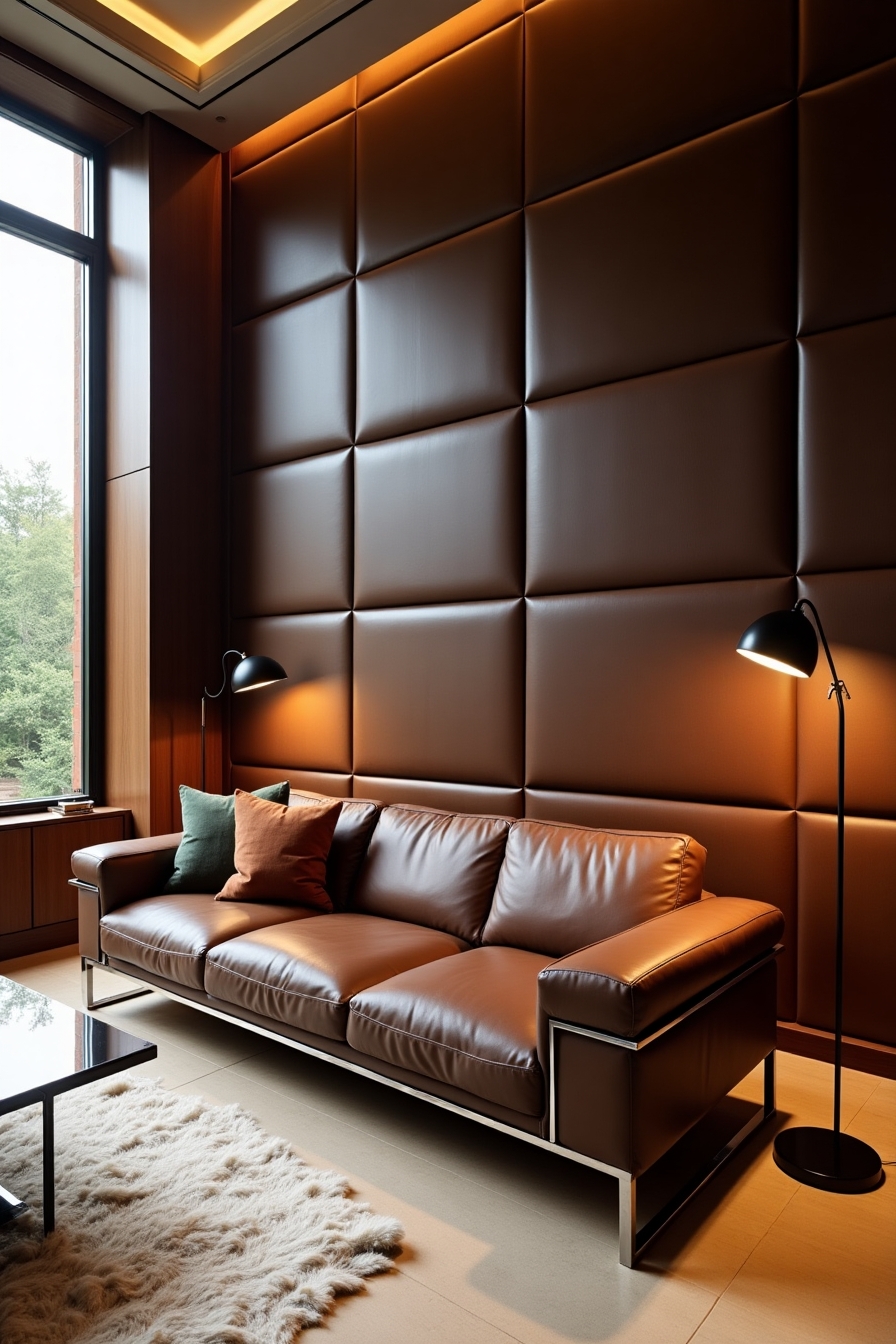I believe walls are the most underutilized canvas in most homes, just sitting there begging for some personality beyond basic paint.
The right wall panel can instantly transform any room from forgettable to jaw-dropping without major construction or commitment.
Modern wall panels have evolved dramatically in recent years, offering incredible design possibilities that work with any style from minimalist to maximalist.
Gone are the dated wood panels of decades past – today’s options include everything from 3D geometric patterns to illuminated stone and living plant walls.
✨Click to Get My 101 FREE Designer Room Ideas
3D Geometric Panels That Play With Light


Imagine walking into a room where the walls seem to dance with shadows and light throughout the day.
That’s exactly what 3D geometric wall panels deliver—a mesmerizing visual experience that transforms with the sun’s movement.
These panels feature protruding geometric shapes that cast subtle shadows, creating an ever-changing artwork on your walls.
Most commonly made from PVC, MDF, or eco-friendly plant fibers, these panels are surprisingly affordable, typically ranging from $2-$10 per square foot depending on material quality.
Installation is surprisingly straightforward—most panels come with interlocking systems or can be attached with construction adhesive and finishing nails.
The living room and dining areas benefit most from this style, as the changing natural light throughout the day highlights the dimensional aspects of the panels.
They work exceptionally well in minimal, modern, or Scandinavian-inspired spaces where the walls themselves become the focal point.
Maintenance couldn’t be simpler—just dust occasionally with a soft cloth or vacuum with a brush attachment.
For high-traffic areas, choose PVC panels that can be wiped clean with mild soap and water.
The beauty of geometric panels lies in their versatility—they can be painted any color to match your decor or left white for a clean, sophisticated look.
Some homeowners install LED strip lighting at strategic points to enhance the 3D effect at night, creating a truly spectacular ambiance for entertaining.
Before purchasing, consider ordering a sample to see how the pattern looks in your specific lighting conditions.
The transformation is immediate—one day of installation work can completely revolutionize a room that’s felt stagnant for years.
Reclaimed Wood Panels for Rustic Warmth


Nothing brings instant character and history to a space quite like reclaimed wood wall panels.
Each plank tells a story through its weathered texture, varying colors, and occasional nail holes or saw marks.
This isn’t your grandparents’ wood paneling—today’s reclaimed wood installations feature thoughtful arrangements, sometimes mixing horizontal and vertical orientations for added visual interest.
Sourced from old barns, factories, or even wine barrels, authentic reclaimed wood typically costs between $10-$25 per square foot, though convincing engineered alternatives are available at half the price.
Installation requires basic carpentry skills—you’ll need to secure furring strips to the wall first, then attach the wood planks using finishing nails or construction adhesive.
Bedrooms and home offices particularly benefit from wood panels, as the natural material creates a cozy, grounding atmosphere perfect for relaxation or concentration.
The beauty of reclaimed wood is its compatibility with multiple design styles—it pairs beautifully with industrial elements like exposed pipes and metal fixtures, but also complements farmhouse, rustic, or even eclectic décor.
To maintain your panels, simply dust regularly and occasionally treat with wood conditioner to prevent excessive drying.
A protective sealer can make cleaning easier and prevent splinters in high-traffic areas.
Consider creating an accent wall rather than covering an entire room—the dramatic effect of a single reclaimed wood wall often outshines a fully paneled space.
For added character, intersperse planks of different widths or incorporate a few planks stained in contrasting colors.
Many suppliers now offer reclaimed wood that’s been kiln-dried to prevent insect problems and eliminate musty odors, making it perfect for indoor use.
The transformation is remarkable—clients consistently report that their reclaimed wood walls become the most commented-on feature of their homes.
Leather Wall Panels for Luxurious Sophistication

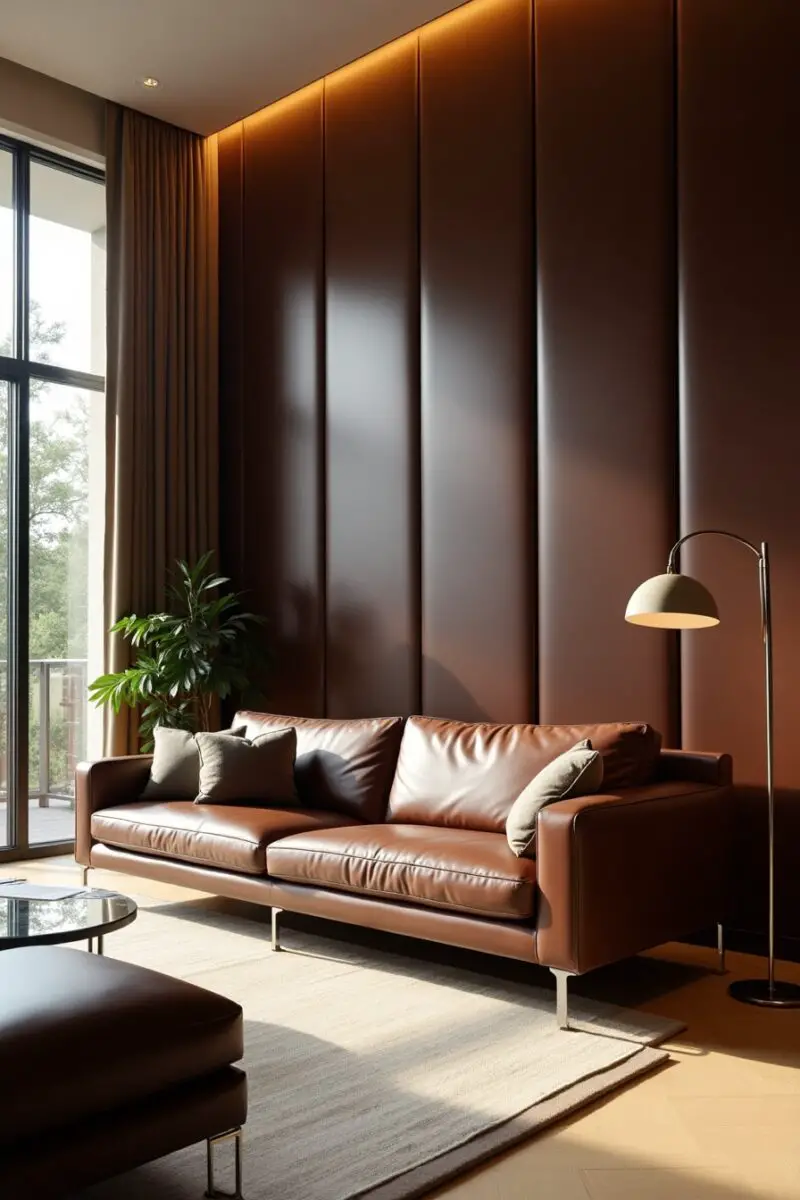
Few wall treatments scream luxury quite like genuine or faux leather panels.
The rich texture, subtle sheen, and unmistakable sophistication of leather immediately elevates any space from ordinary to extraordinary.
Modern leather wall panels come in a variety of configurations—from padded square or rectangular tiles to intricate geometric patterns or tufted designs reminiscent of classic Chesterfield furniture.
Real leather panels typically cost between $15-$40 per square foot, while high-quality faux leather options range from $8-$20, making luxury accessible at various budget points.
Installation methods vary—some systems use clips or tracks, while others attach directly to the wall with specialized adhesive designed for leather applications.
Home offices, media rooms, and upscale dining areas benefit tremendously from leather panels, which add acoustic dampening properties along with their visual appeal.
The rich texture works wonderfully in traditional, contemporary, and even industrial spaces when paired with the right complementary elements.
Maintenance involves occasional dusting and the occasional wipe-down with leather conditioner to maintain suppleness and prevent cracking.
Faux leather options typically require even less maintenance—just a quick wipe with a damp cloth keeps them looking pristine.
Color options range from classic browns and blacks to unexpected blues, greens, and even metallics that catch the light in sophisticated ways.
Consider incorporating contrasting stitching or decorative nailheads for additional visual interest and texture.
For a truly custom look, some manufacturers offer laser-etched leather panels with personalized patterns or designs.
In entertainment spaces, leather panels create an atmosphere of exclusive comfort—like being in a high-end hotel or private club.
The most striking installations often combine leather panels with complementary materials like wood or metal for a multi-dimensional design statement.
Acoustic Felt Panels for Style and Sound Control

Modern living demands solutions that are both beautiful and functional—acoustic felt wall panels deliver brilliantly on both fronts.
These textured panels transform your walls visually while dramatically improving sound quality by reducing echo and absorbing ambient noise.
Available in countless colors, patterns, and 3D designs, felt panels have evolved far beyond utilitarian office dividers into genuine artistic statements for residential spaces.
Pricing typically ranges from $8-$30 per square foot depending on thickness, design complexity, and mounting systems.
Installation is among the easiest of all panel types—most are designed with peel-and-stick backings or simple clip systems that make DIY installation a breeze.
Home theaters, music rooms, open-concept living spaces, and children’s playrooms benefit enormously from the noise-dampening properties of felt panels.
The soft texture creates visual warmth that works with contemporary, Scandinavian, and even industrial design schemes.
Maintenance couldn’t be simpler—vacuum occasionally with a brush attachment or use a lint roller to remove dust and pet hair.
Most felt panels are naturally stain-resistant, but spot cleaning with mild soap and water handles any occasional marks.
The material is often made from recycled plastic bottles, adding eco-friendly credentials to your design choices.
Consider mixing panels of different colors or depths to create custom wall art that serves double-duty as sound control.
Some homeowners create stunning ombre effects by arranging panels in graduated color patterns across their walls.
For family homes, the soft surface eliminates concerns about children bumping into hard wall surfaces—an added safety benefit.
Creative designers now offer felt panels with integrated LED lighting that transforms walls into dramatic light displays with the additional benefit of sound absorption.
The impact on room acoustics is immediately noticeable—conversations become clearer, music sounds more precise, and the overall noise level in busy households decreases significantly.
✨Click to Get My 101 FREE Designer Room Ideas
Backlit Onyx Panels for Dramatic Illumination


Nothing creates a more jaw-dropping wall feature than translucent onyx stone panels with strategic backlighting.
These stunning natural stone panels transform from beautiful to breathtaking when illuminated, revealing intricate veining patterns and color variations hidden within the stone.
Real onyx is a semi-precious stone with translucent properties that allow light to penetrate through its crystalline structure, creating a glowing effect that artificial materials simply cannot replicate.
While undeniably the most premium option on this list at $100-$300 per square foot installed, more affordable alternatives using resin with onyx effects or printed glass are available at $30-$80 per square foot.
Installation requires professional expertise—the panels must be properly secured and the LED lighting system correctly installed with dimming capabilities to maximize the dramatic effect.
Powder rooms, master bathrooms, and statement walls in dining rooms or entrance foyers benefit most from this luxury treatment.
The ethereal glow of backlit onyx works in ultra-modern, luxury contemporary, and even updated traditional spaces that embrace dramatic architectural elements.
Maintenance involves gentle cleaning with stone-specific products and occasional resealing depending on the location and exposure to moisture.
Each panel is completely unique—the natural formations in the stone ensure that your wall is truly one-of-a-kind and impossible to duplicate.
The most spectacular installations feature book-matched panels, where slices of stone are arranged to create mirror-image patterns across the wall.
Adding a programmable lighting system allows you to change the intensity and sometimes even the color of the backlighting to match different moods or occasions.
Designers often combine backlit onyx with other luxury materials like brushed brass trim or dark wood cabinetry to create spaces with undeniable opulence.
The transformative power of properly illuminated onyx cannot be overstated—it’s quite literally like having a glowing work of natural art embedded in your home.
Fluted Wood Panels for Textured Elegance



The gentle rhythm of vertically grooved wood panels creates a sophisticated cadence that elevates walls from flat surfaces to textured design elements.
Fluted panels feature repeating rounded channels or grooves carved into wood or MDF, creating subtle shadow lines that add depth without overwhelming a space.
This contemporary take on traditional paneling has exploded in popularity in recent years, appearing in high-end homes, boutique hotels, and luxury retail spaces worldwide.
Cost varies widely from $10-$50 per square foot depending on whether you choose real wood, engineered options, or MDF versions that can be painted any color.
Installation typically involves securing the panels directly to wall studs or to a plywood substrate using construction adhesive and finishing nails.
Entryways, television walls, bathroom vanity backsplashes, and behind-bed feature walls are perfect locations for this versatile treatment.
The vertical lines naturally draw the eye upward, making fluted panels particularly effective in spaces with low ceilings that need a visual lift.
Maintenance is straightforward—dusting regularly and occasional cleaning with wood-appropriate products keeps them looking pristine.
Painted versions offer the most design flexibility, allowing you to match or contrast with your existing color scheme.
Natural wood options in oak, walnut, or ash showcase the beautiful grain patterns between the flutes, adding another layer of visual interest.
Consider integrating hidden doors into your fluted paneling for a sleek, seamless look that conceals storage or entryways.
For a truly custom look, some designers vary the width and depth of the flutes, creating unique patterns that break from the expected rhythm.
The acoustical benefits are a hidden bonus—the grooved surface helps diffuse sound and reduce echo in large spaces.
LED strip lighting installed at the top or bottom of fluted panels creates dramatic shadows that emphasize the textural quality, especially striking in evening lighting.
What makes fluted panels particularly versatile is their ability to bridge traditional and contemporary design—they reference classical architecture while maintaining clean, modern lines.
Concrete Panels for Industrial Chic


The raw, unfiltered appeal of concrete brings an edgy, industrial aesthetic that’s impossible to achieve with paint or conventional materials.
Modern concrete wall panels aren’t the cold, institutional surfaces you might imagine—today’s options include various textures, embedded objects, and even customized color variations.
Available in real concrete (typically 1/4″ to 1/2″ thick to reduce weight) or lightweight concrete-look alternatives made from fiberglass reinforced gypsum, these panels bring authentic industrial character without major structural reinforcement.
Pricing ranges from $15-$60 per square foot depending on customization, authenticity, and installation complexity.
Installation of real concrete panels often requires professional help due to weight considerations, while lightweight alternatives can be manageable DIY projects.
Urban lofts, contemporary kitchens, fireplace surrounds, and minimalist bathrooms are ideal locations for concrete panel treatments.
The raw texture works beautifully in industrial, minimalist, brutalist, and even some Scandinavian-inspired designs that embrace natural materials.
Maintenance is surprisingly simple—a quick dusting and occasional wipe-down with a damp cloth is typically all that’s needed.
Sealed concrete panels resist staining and can be cleaned with mild soap and water when necessary.
The color palette extends beyond expected greys to include whites, blacks, earth tones, and even custom-colored options with subtle pigmentation.
Consider panels with exposed aggregate, which incorporates small stones or glass pieces into the surface for additional textural interest.
Some manufacturers offer concrete panels embedded with fossils, metal fragments, or botanical elements for truly unique wall features.
The temperature-regulating properties of concrete make these panels practical as well as beautiful—they naturally help maintain consistent room temperatures.
For dramatic effect, designers often combine concrete panels with contrasting warm elements like wood or leather to balance the coolness of the material.
What makes concrete particularly special is its authenticity—in a world of artificial finishes, real concrete panels tell a truth about materials that discerning guests immediately recognize and appreciate.
Woven Rattan Panels for Tropical Sophistication
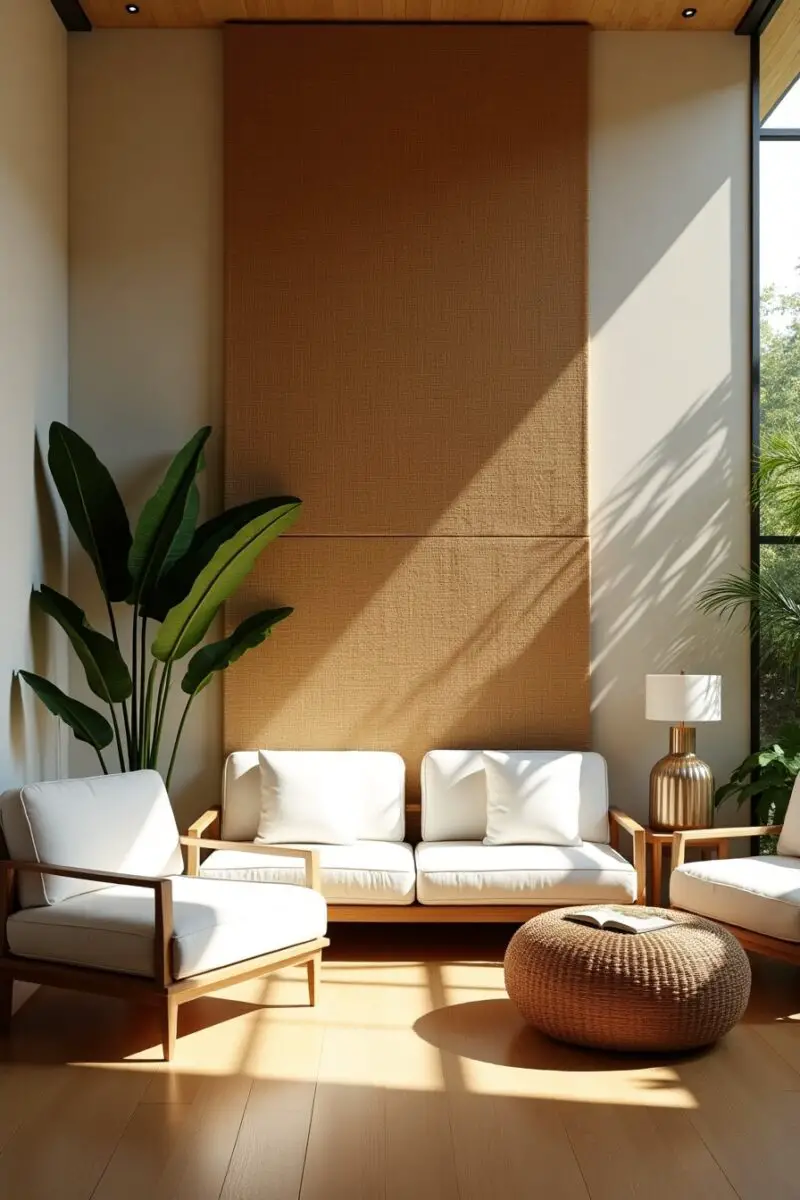

The intricate patterns of woven rattan bring natural texture and a hint of tropical elegance to walls that crave organic character.
These panels transform rooms with their handcrafted appeal, featuring variations in weave patterns from tight geometric designs to more open, airy configurations.
Made from the thin stems of rattan palms, these sustainable panels add environmental credentials to their design appeal.
Cost typically ranges from $20-$60 per square foot for authentic rattan panels, while synthetic alternatives are available at $10-$30 per square foot.
Installation is relatively straightforward—panels are typically attached to wooden frames that are then secured to the wall, creating a slight dimensional effect.
Bedrooms, dining areas, home offices, and sunrooms particularly benefit from the warm, natural character of rattan panels.
The texture works beautifully in coastal, bohemian, tropical modern, and even traditional spaces that need a touch of relaxed sophistication.
Maintenance involves occasional dusting and keeping panels away from excessive moisture, which can cause warping over time.
The natural golden honey color of rattan works as a neutral that complements almost any color palette.
For a more contemporary look, some designers paint rattan panels in unexpected colors like navy, emerald, or even matte black while preserving the textural interest.
Consider creating picture-frame-like sections of rattan panels rather than covering entire walls—the material makes a stronger statement when used with intention.
The natural variations in color and pattern make each installation completely unique, telling a story of handcraftsmanship that mass-produced materials cannot match.
In spaces with challenging acoustics, rattan panels help diffuse sound waves and reduce echo without the obvious appearance of acoustic treatments.
Lighting plays a crucial role in showcasing rattan—directional lighting that casts shadows across the woven patterns brings out the dimensional quality of the material.
What makes rattan particularly appealing is its ability to bring organic warmth to contemporary spaces that might otherwise feel cold or impersonal.
✨Click to Get My 101 FREE Designer Room Ideas
Mirror Mosaic Panels for Light-Amplifying Glamour
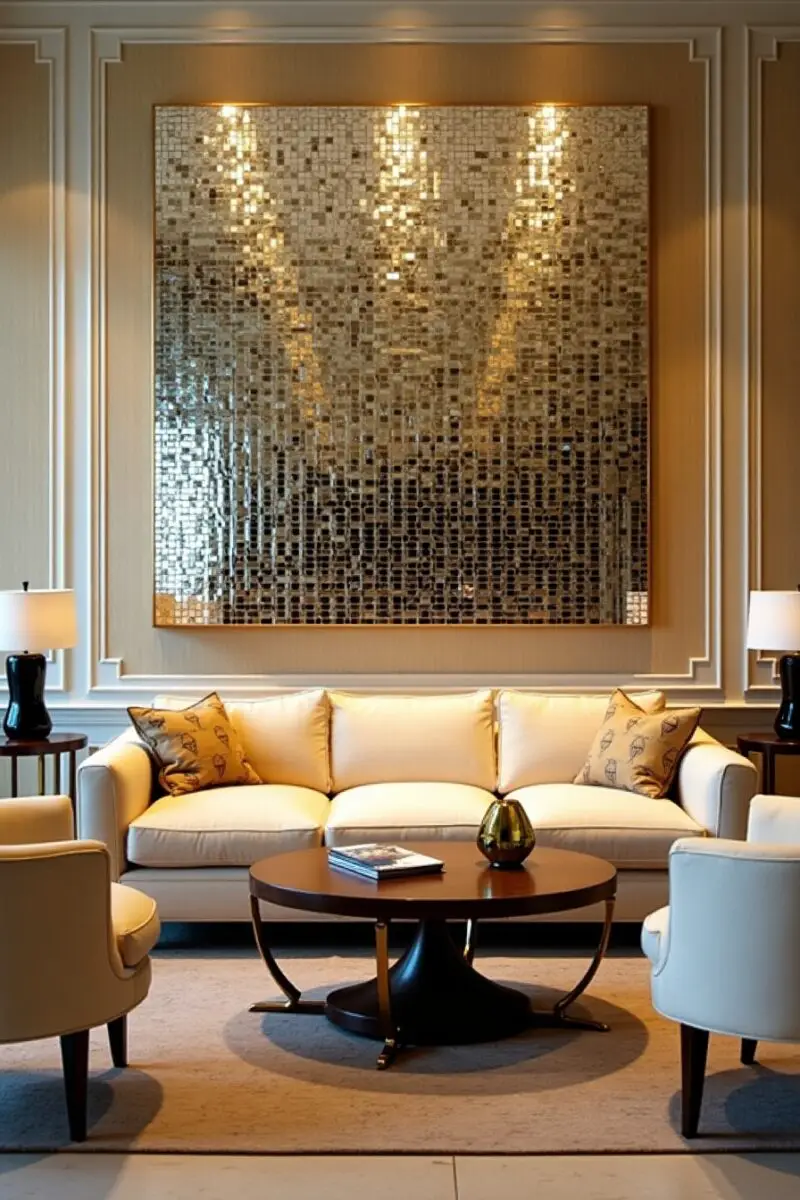

Nothing transforms a space quite like the dazzling play of light across hundreds of mirrored facets arranged in geometric patterns.
Mirror mosaic panels create instant drama, visually expanding spaces while reflecting light in captivating, kaleidoscopic patterns.
Modern versions have moved far beyond disco-era designs to include sophisticated arrangements in metallic tints, antique finishes, and even mixed materials like glass and metal.
Pricing typically ranges from $15-$70 per square foot depending on the complexity of the pattern and quality of materials.
Installation requires precision but is manageable as a DIY project—panels are typically applied with specialized mirror adhesive and sometimes finished with coordinating grout.
Powder rooms, dining areas, entryways, and smaller spaces that benefit from light amplification are ideal locations for mirror mosaic treatments.
The reflective quality works exceptionally well in art deco, glam, contemporary, and even some maximalist design schemes that embrace visual excitement.
Maintenance involves regular dusting and occasional cleaning with non-abrasive glass cleaner, taking care not to allow liquid to seep behind the panels.
Some designers create stunning effects by combining mirrored tiles with complementary colored glass for a custom pattern.
Consider incorporating mirror mosaics in unexpected places like the ceiling of a small powder room or the back of a bookshelf for a surprising glimmer.
LED lighting strategically placed to reflect off mirrored surfaces creates a magical evening ambiance that transforms ordinary rooms into extraordinary spaces.
For a more subtle approach, smoky or antiqued mirror mosaics offer reflection without the brightness of clear mirror, creating a softer, more sophisticated effect.
The most successful installations often use mirror panels selectively—a single feature wall or column that becomes the jewelry of the room.
Beyond their aesthetic appeal, mirror mosaics serve the practical purpose of making small spaces feel significantly larger and brighter.
What makes mirrored panels particularly valuable is their dual functionality—they’re simultaneously decorative and practical, enhancing both the appearance and perceived size of your space.
Moss and Living Plant Walls for Biophilic Design
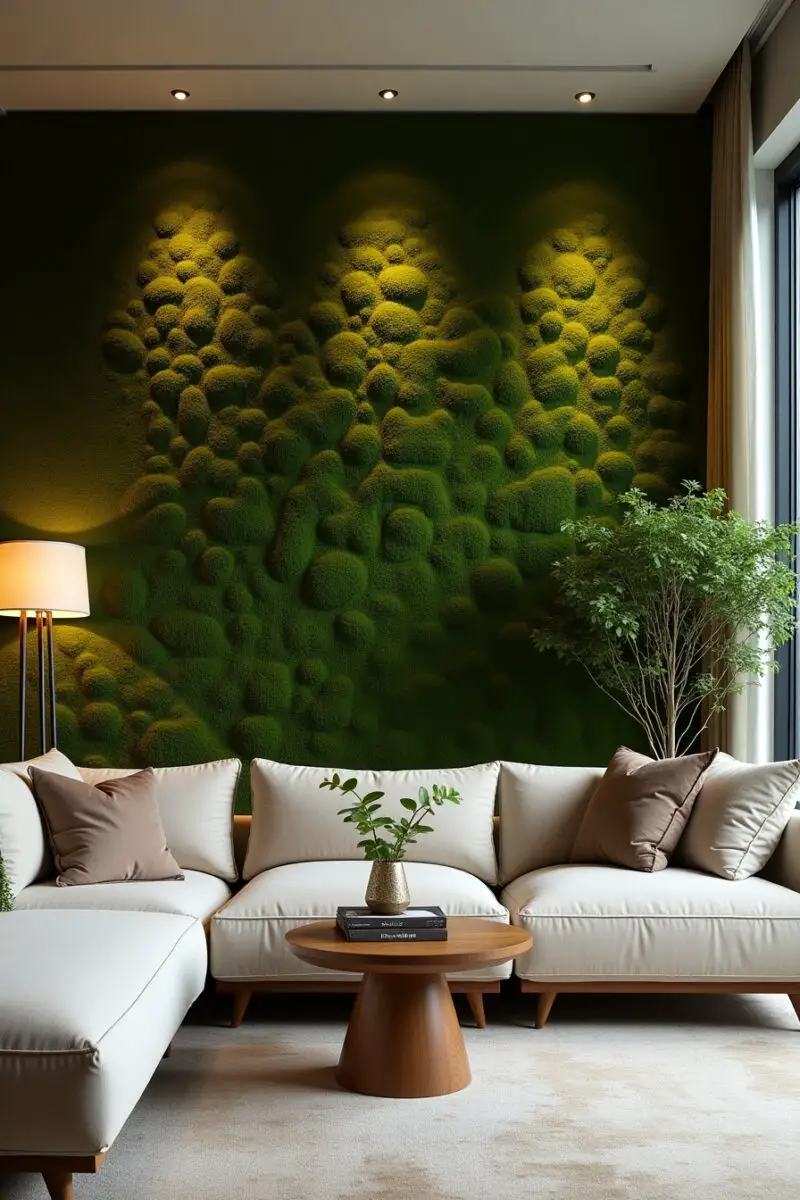

Imagine the tranquil beauty of a forest floor transported to your interior walls—preserved moss and living plant panels bring exactly this natural magic indoors.
These verdant installations transform ordinary walls into lush vertical gardens that connect interior spaces to the natural world in the most direct way possible.
Available in both preserved (no maintenance) and living (requiring irrigation systems) versions, these panels range from simple moss coverings to complex arrangements of multiple plant species.
Preserved moss panels typically cost $60-$150 per square foot, while living walls with irrigation systems range from $100-$300 per square foot installed.
Installation of preserved panels is relatively straightforward, while living walls require professional installation of irrigation and drainage systems.
Wellness rooms, meditation spaces, bathrooms with adequate light, and corporate reception areas benefit most from the stress-reducing properties of plant walls.
The organic texture works beautifully in biophilic, contemporary, spa-inspired, and even minimalist spaces that need a counterpoint to hard surfaces.
Maintenance varies dramatically—preserved moss requires no watering or light, while living walls need regular attention to irrigation, lighting, and plant health.
The color palette extends far beyond expected greens to include preserved moss in purples, blues, and even custom colors for brand-specific installations.
Consider combining preserved moss with living plants for a lower-maintenance option that still includes some dynamic growing elements.
Some designers incorporate wooden or metal elements within plant walls to create geometric patterns or company logos for corporate spaces.
For homes with limited natural light, preserved moss offers the biophilic benefits without the light requirements of living plants.
Research has demonstrated that even brief exposure to natural elements like plant walls can reduce stress hormones and improve cognitive function.
The acoustic benefits are significant—plant material absorbs sound waves, making moss walls particularly valuable in echo-prone spaces with hard surfaces.
What makes plant walls truly special is their ability to change the feeling of a space at a primal level—connecting occupants to nature in our increasingly digital and artificial environments.

